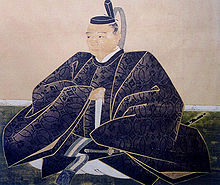Katō Yoshiaki
Katō Yoshiaki | |
|---|---|
| 加藤 嘉明 | |
 Katō Yoshiaki | |
| Lord of Aizu | |
| In office 1627–1631 | |
| Preceded by | Gamō Tadasato |
| Succeeded by | Katō Akinari |
| Personal details | |
| Born | 1563 |
| Died | October 7, 1631 (aged 67–68) |
| Nationality | Japanese |
| Military service | |
| Allegiance | |
| Unit | |
| Battles/wars | Battle of Shizugatake (1583) Siege of Shimoda (1590) Korean Campaign (1592-1598) Battle of Sekigahara (1600) |
Katō Yoshiaki (加藤 嘉明, 1563 – October 7, 1631) was a Japanese daimyō of the late Sengoku period to early Edo period who served as lord of the Aizu Domain. A retainer of Toyotomi Hideyoshi, he fought in the battle of Shizugatake in 1583, and soon became known as one of the shichi-hon-yari (七本槍), or Seven Spears of Shizugatake.[1]

Yoshiaki was one of Hideyoshi's seven most trusted and experienced generals. He was involved in the bitter naval battles at Siege of Shimoda in the Odawara Campaign (1590) and fought off the coast of southern Korean peninsula during the 1st and 2nd Korean Campaign, many of which went in favor of the Korean navy.
Conflict with Ishida Mitsunari[edit]
According to popular theory In 1598 after the death of Toyotomi Hideyoshi, the government of Japan have an accident when seven military generals consisted of Fukushima Masanori, Katō Kiyomasa, Ikeda Terumasa, Hosokawa Tadaoki, Asano Yoshinaga, Katō Yoshiaki, and Kuroda Nagamasa planned a conspiracy to kill Ishida Mitsunari. It was said that the reason of this conspiracy was dissatisfaction of those generals towards Mitsunari as he wrote bad assessments and underreported the achievements of those generals during the Imjin war against Korea & Chinese empire.[2] At first, these generals gathered at Kiyomasa's mansion in Osaka Castle, and from there they moved into Mitsunari's mansion. However, Mitsunari learned of this through a report from a servant of Toyotomi Hideyori named Jiemon Kuwajima, and fled to Satake Yoshinobu's mansion together with Shima Sakon and others to hide.[2] When the seven generals found out that Mitsunari was not in the mansion, they searched the mansions of various feudal lords in Osaka Castle, and Kato's army also approached the Satake residence. Therefore, Mitsunari and his party escaped from the Satake residence and barricaded themselves at Fushimi Castle.[3] The next day, the seven generals surrounded Fushimi Castle with their soldiers as they knew Mitsunari was hiding there. Tokugawa Ieyasu, who was in charge of political affairs in Fushimi Castle trying to arbitrate the situation. The seven generals requested Ieyasu to hand over Mitsunari, which refused by Ieyasu. Ieyasu then negotiated the promised to let Mitsunari retire and to review the assessment of the Battle of Ulsan Castle in Korea which became the major source of this incident, and had his second son, Yūki Hideyasu, to escort Mitsunari to Sawayama Castle.[4] However, historian Watanabe Daimon stated from the primary and secondary sources text about the accident this was more of legal conflict between those generals with Mitsunari, rather than conspiracy to murder him. The role of Ieyasu here was not to physically protect Mitsunari from any physical harm from them, but to mediate the complaints of those generals.[5]
Nevertheless, historians viewed this incident were not just simply personal problems between those seven generals against Mitsunari, as it was viewed as an extention of the political rivalries on greater scope between Tokugawa faction and anti-Tokugawa faction which led by Mitsunari. Since this incident, those military figures who had bad terms with Mitsunari would support Ieyasu later during the conflict of Sekigahara between Eastern army led by Tokugawa Ieyasu and Western army led by Ishida Mitsunari.[2][6] Muramatsu Shunkichi, writer of "The Surprising Colors and Desires of the Heroes of Japanese History and violent womens”, gave his assessment that the reason of Mitsunari failure in his war against Ieyasu was due to his unpopularity among the major political figures of that time.[7]
In 1600, Katō fought alongside Tokugawa Ieyasu. Following the important victory at Sekigahara in 1600, Tokugawa doubled Katō's fief from 100,000 koku to 200,000. For a time, he was lord of Aizu.
See also[edit]
Popular culture[edit]
- Portrayed by Kim Kang-il in the 2014 film The Admiral: Roaring Currents.
- Portrayed by Kim Sung-kyun in the 2022 film Hansan: Rising Dragon.
References[edit]
- ^ Turnbull, Stephen (1998). The Samurai Sourcebook. London: Cassell & Co. p. 34,49,234,241. ISBN 9781854095237.
- ^ a b c Mizuno Goki (2013). "前田利家の死と石田三成襲撃事件" [Death of Toshiie Maeda and attack on Mitsunari Ishida]. 政治経済史学 (in Japanese) (557号).
- ^ Kasaya Kazuhiko (2000). "豊臣七将の石田三成襲撃事件―歴史認識形成のメカニズムとその陥穽―" [Seven Toyotomi Generals' Attack on Ishida Mitsunari - Mechanism of formation of historical perception and its downfall]. 日本研究 (in Japanese) (22集).
- ^ Kasaya Kazuhiko (2000). "徳川家康の人情と決断―三成"隠匿"の顚末とその意義―" [Tokugawa Ieyasu's humanity and decisions - The story of Mitsunari's "concealment" and its significance]. 大日光 (70号).
- ^ "七将に襲撃された石田三成が徳川家康に助けを求めたというのは誤りだった". yahoo.co.jp/expert/articles/ (in Japanese). 渡邊大門 無断転載を禁じます。 © LY Corporation. Retrieved 2 June 2024.
- ^ Mizuno Goki (2016). "石田三成襲撃事件の真相とは". In Watanabe Daimon (ed.). 戦国史の俗説を覆す [What is the truth behind the Ishida Mitsunari attack?] (in Japanese). 柏書房.
- ^ 歴代文化皇國史大觀 [Overview of history of past cultural empires] (in Japanese). Japan: Oriental Cultural Association. 1934. p. 592. Retrieved 23 May 2024.
